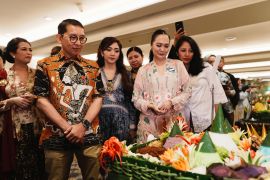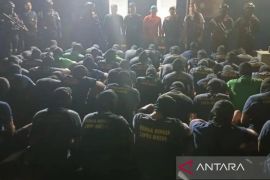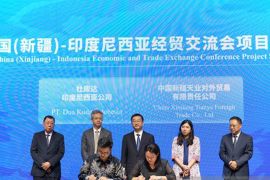Malls and shops specializing in selling Islamic clothing are mushrooming in Jakarta and other cities, including Thamrin City, Tanah Abang, and Cempaka Mas Malls.Jakarta (ANTARA News) - Indonesia, the worlds largest Muslim population, needs creativity to support its ambition to become a global Islamic fashion capital, particularly for Muslim women.
Indonesia has a population of over 250 million, of which 85 percent are Muslims.
Increasingly more Indonesian Muslim women, including young girls, are opting to wear Islamic clothing as they are fashionable, decent, practical, comfortable, and alluring.
Deputy Minister of Cooperatives and SMEs Emilia Suhaimi is even convinced that Indonesia deserves to become the global Islamic fashion capital by 2020.
"We know that Indonesia has been designated (to become) the worlds Islamic fashion capital by 2020, and the country is nearing that target from time to time," Suhaimi said here on Monday.
Besides being the largest Muslim populated country in the world, Indonesias Islamic culture is open to modernization, tolerance, pluralism and diversity, she added.
"Indonesias hijabs are very unique and varied, compared to those in other countries," she noted.
Furthermore, Indonesia has ample human resources who are creative, thanks to the nations rich cultural heritage, she remarked.
Traditional dresses in Aceh, Minang (West Sumatra) and other regions cover womens bodies well and are close to the Muslim sense of fashion, she added.
Since 1990, the Muslim fashion industry in Indonesia has progressed rapidly.
"This has convinced us that Indonesia has the potential to become one of the worlds fashion centers, particularly when it comes to Muslim fashion, because the country has creative human resources and a rich cultural heritage," she said.
Indonesia also has talented fashion designers and good fabrics that could support the garment industry.
She said the designs of Indonesian Muslim dresses are beautiful because they follow the latest trends while still maintaining the local cultural elements.
Besides covering womens bodies, Indonesian Muslim dresses are comfortable, elegant, fashionable, and have ethnic elements.
Malls and shops specializing in selling Islamic clothing are mushrooming in Jakarta and other cities, including Thamrin City, Tanah Abang, and Cempaka Mas Malls.
Specific shops offering high-quality Islamic fashion are the Shafira, Al-Fira, Al-Misa, Kisa, Zara, Zahra, and Rabbani, among others.
Online Muslim shops are also on the rise. They include Hijabenka HijUp, Saqina, Muslimarket, Zoya, Zalora, Elzatta, Idhijab, Rahma o-shop, Artizara, Inayah, and Modanisa.
Islamic fashion shows are organized every year in Jakarta and other cities to help promote the domestic Islamic fashion at the international level.
The events included Indonesian Muslim Fashion Week (IMFW) which was organized in Bandung, West Java, on July 18-20, 2014, featuring the latest works of 28 Indonesian Muslim fashion designers.
"The theme of IMFW 2014 was "From Indonesia to the World." IMFW is expected to become a world Muslim fashion hub in the future," IMFW coordinating committee chairman Pradito Rukmana said.
"This is an opportune moment because it coincides with Ramadan fasting month. Now, we see that hijab has become a lifestyle," Rukmana said.
The 28 designers participating in the fashion week include Dian Pelangi, Jenahara, Ria Miranda, Ria Baraba, Ghaida, Acha Septriasa, Irfan Hakim, Zaskia Adya Meca, and Nuri Maulida.
In September 2015, the annual International Indonesian Islamic Fashion Fair was organized at the Jakarta Convention Center (JCC) by the Indonesia Islamic Fashion Consortium (IIFC), a collective of Indonesian fashion designers, industry associations, government agencies, media, and other fashion-related entities, which harbor the mutual goal of developing the potential of Indonesias modest fashion industry.
In addition, the government had encouraged Muslim fashion designers to participate in overseas exhibitions.
Indonesia is a huge market for Muslim fashion products. Overseas markets such as those in Malaysia, Middle Eastern countries, Europe, and America are also still wide open.
Arabian.Business.com wrote on September 5, 2015, that Islamic fashion sector expenditure reached $230 billion, constituting 11 percent of the global fashion market in 2014.
"But the sector will be worth $327 billion by 2020, according to the upcoming State of the Global Islamic Economy report, to be published in conjunction with the Global Islamic Economy Summit taking place in Dubai this October," the online media reported.
The 1.6 billion Muslim consumers spent $266 billion on clothing in 2013, and are projected to spend $484 billion by 2019, according to a report by Thomson Reuters and Dinar Standard, a Muslim market research firm.
"It wouldnt be very wise of retailers to not be inclusive anymore," Alia Khan, chairperson of the Islamic Fashion and Design Council, who moderated the panel "Modest Fashion Takes Centre Stage" at the recent GIE Summit, told Khaleej Times. "This is a very legitimate and strong market and they need to acknowledge, cater and satisfy it," she was quoted as saying by Khaleej Times in October 2015.(*)
Reporter: Fardah
Editor: Heru Purwanto
Copyright © ANTARA 2015











